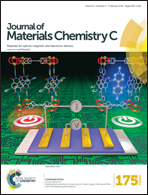Organic photodiodes constructed from a single radial heterojunction microwire†
Abstract
Organic nano/micro one-dimensional (1D) materials are generally considered as promising materials for flexible, portable optoelectronic devices due to their well-known distinctive feature. Over the past few years, numerous organic nano/micro 1D photosensitive resistors have been developed; however, as one of the important photoelectronic components for fabricating organic nano/microelectronic circuits, organic nano/micro 1D photodiodes have not been reported yet. Herein, on the basis of our previous work about an organic photosensitive radial heterostructure microwire, we tried to prepare another kind of radial heterostructure microwire and explore its photodiode properties. Excitingly, the organic radial heterostructure microwire using aluminum tris(8-hydroxyquinoline) as the core and poly(3-hexyl thiophene) as the shell, which was prepared by a solution-based method, showed excellent performance with a large rectification ratio, a high on/off ratio and a good photoresponsivity under ambient conditions. Our work has developed a convenient method to prepare microwire photodiodes based on an all-organic heterojunction.


 Please wait while we load your content...
Please wait while we load your content...